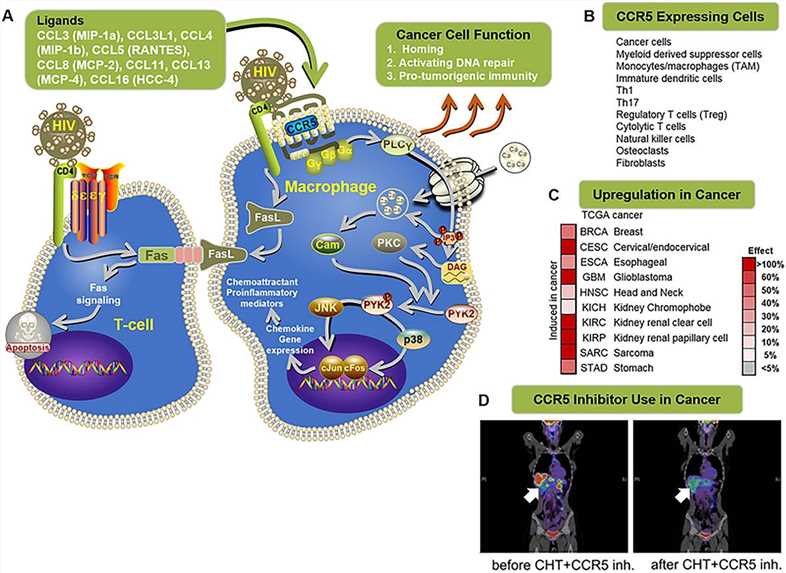CCR5 Assay Portfolio Service
Research has shown the importance of the C-C chemokine receptor type 5 (CCR5) in human diseases. Additionally, CCL5/CCR5 axis abstracts increasing attention due to abnormal activity and expression of CCL5 and its receptor CCR5 has been found in hematological malignancies and solid tumors. With advanced and high-end technologies, rich experienced scientists, Creative Biolabs is an excellent service provider in the field of tumor marker assay. After long years ahead to fully comprehend tumor markers, we launch our CCR5 assay portfolio service which can be useful for targeted cancer therapy and diagnosis.
CCR5 and Signal Transduction
CCR5, a seven-transmembrane G-protein coupled receptor, binds multiple ligands including CCL3, CCL3L1, CCL4, CCL5, CCL8, CCL11, CCL13, and CCL16. The high-expressed level of CCR5 is discovered in multiple cancers, such as melanoma, breast cancer, gastric cancer, prostate cancer, colorectal carcinoma, Hodgkin's lymphoma head and neck cancer, esophageal cancer, pancreatic cancer, acute lymphocytic leukemia and other tumors.
CCR5 activation of Ca2+ signaling and cell migration can be preserved in immune cells and cancer cells. Pathways induced by CCR5, promote cap-dependent translation by inducing cell survival, proliferation, glycolysis, growth, and proliferation of progenitor and stem cells, immune cell differentiation and the release of eIF4E. CCR5 regulates the physiological functions of immune cells including T cells, eosinophils, macrophages, myeloid-derived suppressor cells, microglia and dendritic cells. Additionally, pathological expression of CCR5 upon cellular transformation occurs in many types of cancer.
 Fig.1 CCR5 signaling in immune and cancer cells. (Jiao, 2019)
Fig.1 CCR5 signaling in immune and cancer cells. (Jiao, 2019)
CCL5/CCR5 Axis in Cancer
 Fig.2 Involvement of the CCL5/CCR5 axis in cancer progression. (Aldinucci, 2020)
Fig.2 Involvement of the CCL5/CCR5 axis in cancer progression. (Aldinucci, 2020)
CCL5/CCR5 axis promotes tumor progression through several mechanisms.
-
CCL5 secreted by tumor cells and by the TME, increases tumor growth.
-
CCL5 induces collagen degradation by activating matrix metalloproteinases in macrophages and fibroblasts.
-
CCL5 increases tumor cell migration and invasion by integrin activation and actin polarization.
-
CCR5+ cancer cells show characteristics of cancer stem cells.
-
CCR5 expression is associated with stronger repair responses to DNA damage induced by doxorubicin and γ-irradiation.
-
CCL5 secreted by tumor cells and by the TME decreases drug cytotoxic activity.
-
CCR5 engagement stimulates glucose uptake, glycolysis, pentose phosphate pathway, fatty acid synthesis, and glutamine metabolism.
-
CCL5 promotes endothelial cell migration and neovessel formation and induces the secretion of VEGF by endothelial cells.
-
CCL5 secreted by tumor cells recruits normal cells to build the TME.
-
CCL5 induces the immunosuppressive polarization of monocytes and myeloid cells leading to M2-TAMs and MDSCs that induce exhaustion of effector T-cells.
CCR5 Blockade Assays at Creative Biolabs Including but Not Limited to:
-
Invasion assay
-
Metastasis assay
-
Migration assay
-
Proliferate assay
-
Angiogenesis assay
If you are interested in our service, please contact us or directly send us.
References
-
Jiao, X.; et al. Recent advances targeting CCR5 for cancer and its role in immuno-oncology. Cancer Res. 2019, 79(19): 4801-4807.
-
Aldinucci, D.; et al. The CCL5/CCR5 axis in cancer progression. Cancers (Basel). 2020, 12(7): 1765.
For Research Use Only | Not For Clinical Use


 Fig.1 CCR5 signaling in immune and cancer cells. (Jiao, 2019)
Fig.1 CCR5 signaling in immune and cancer cells. (Jiao, 2019)
 Fig.2 Involvement of the CCL5/CCR5 axis in cancer progression. (Aldinucci, 2020)
Fig.2 Involvement of the CCL5/CCR5 axis in cancer progression. (Aldinucci, 2020) Download our brochure
Download our brochure